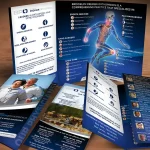Web design plays a crucial role in the success of marketing campaigns. A well-designed website can attract and engage users, increase website traffic, and ultimately drive conversions. In this blog post, we will explore the importance of web design in marketing and how it can be optimized for maximum results. We will also discuss the concepts of perplexity and burstiness, which will be used throughout the article to provide a deeper understanding of the topic.
Perplexity refers to the level of complexity or confusion that a user experiences when interacting with a website. A high perplexity score indicates that the user is finding it difficult to navigate or understand the content, while a low perplexity score suggests that the user is able to easily navigate and comprehend the website. Burstiness, on the other hand, refers to the level of excitement or interest that a user experiences when interacting with a website. A high burstiness score indicates that the user is highly engaged and interested in the content, while a low burstiness score suggests that the user is not very engaged or interested.
Key Takeaways
- Web design plays a crucial role in marketing success.
- User experience is key to maximizing results and should be prioritized in web design.
- Understanding your target audience is essential for effective web design.
- Visual design has a significant impact on marketing success and should be carefully considered.
- Responsive web design is a powerful tool for marketing and should be utilized.
The Importance of Web Design in Marketing
Web design plays a crucial role in the success of marketing campaigns. A well-designed website can attract and engage users, increase website traffic, and ultimately drive conversions. The design of a website can impact how users perceive a brand and its products or services. It can create a positive first impression and establish credibility.
Aesthetically pleasing design elements such as color schemes, typography, and imagery can evoke emotions and create a memorable experience for users. Additionally, a well-designed website should have clear navigation and intuitive user interface (UI) elements to ensure that users can easily find what they are looking for. This can lead to increased time spent on the website and higher chances of conversion.
There are numerous examples of successful marketing campaigns that have utilized great web design to achieve their goals. One such example is Apple’s website, which is known for its sleek and minimalist design. The use of white space, high-quality product images, and simple navigation creates a visually appealing and user-friendly experience. This design approach aligns with Apple’s brand image of simplicity and elegance, and helps to showcase their products effectively.
Another example is Airbnb’s website, which has a clean and modern design that reflects the company’s focus on providing unique and personalized travel experiences. The use of vibrant colors, high-quality images, and clear call-to-action buttons creates a visually engaging and persuasive experience for users. The website also incorporates user-generated content, such as reviews and ratings, to build trust and credibility.
The Role of User Experience in Maximizing Results
User experience (UX) plays a crucial role in maximizing the results of a website. UX refers to the overall experience that a user has when interacting with a website or application. It encompasses factors such as ease of use, accessibility, and satisfaction.
A positive user experience can lead to increased website traffic and engagement. When users have a seamless and enjoyable experience on a website, they are more likely to stay longer, explore more pages, and take desired actions such as making a purchase or submitting a contact form. On the other hand, a poor user experience can lead to high bounce rates and low conversion rates.
There are numerous websites that excel in providing a great user experience. One example is Amazon, which is known for its personalized recommendations, easy checkout process, and fast loading times. The website is designed to make it easy for users to find products they are interested in, read reviews from other customers, and make informed purchasing decisions.
Another example is Spotify, which offers a seamless music streaming experience across different devices. The website has a clean and intuitive interface that allows users to easily search for songs, create playlists, and discover new music. The personalized recommendations and curated playlists enhance the overall user experience and keep users engaged.
Understanding Your Target Audience for Better Web Design
Understanding your target audience is crucial for effective web design. By knowing who your target audience is, you can tailor your website design to meet their specific needs and preferences. This can lead to higher engagement, increased website traffic, and improved conversion rates.
Different target audiences have different preferences when it comes to website design. For example, a website targeting millennials may have a more modern and trendy design, while a website targeting senior citizens may have a simpler and more straightforward design. By understanding the demographics, interests, and behaviors of your target audience, you can create a website that resonates with them and encourages them to take action.
There are numerous websites that cater to specific target audiences effectively. One example is Nike’s website, which targets athletes and sports enthusiasts. The website has a dynamic and energetic design that reflects the brand’s identity and appeals to its target audience. The use of high-quality images, videos, and interactive elements creates an immersive experience for users.
Another example is Etsy, which targets creative individuals who are interested in handmade and unique products. The website has a whimsical and artistic design that reflects the brand’s values and appeals to its target audience. The use of vibrant colors, playful illustrations, and user-generated content creates a sense of community and encourages users to explore and purchase products.
The Impact of Visual Design on Marketing Success
Visual design plays a crucial role in the success of a website. Visual elements such as color schemes, typography, imagery, and layout can evoke emotions, create a memorable experience, and communicate brand values.
Color schemes can evoke different emotions and associations. For example, warm colors such as red and orange can create a sense of excitement and urgency, while cool colors such as blue and green can create a sense of calmness and trust. By choosing the right color scheme for your website, you can create the desired emotional response in your target audience.
Typography is another important visual element that can impact the success of a website. Different fonts have different personalities and can convey different messages. For example, a bold and modern font may be suitable for a technology company, while a classic and elegant font may be suitable for a luxury brand. By choosing the right typography for your website, you can effectively communicate your brand values and create a cohesive visual identity.
Imagery is also crucial in web design. High-quality images can capture attention, evoke emotions, and communicate messages effectively. Whether it’s product photos, lifestyle images, or illustrations, the choice of imagery should align with your brand and resonate with your target audience.
Layout is another important aspect of visual design. A well-organized and visually appealing layout can guide users through the website and highlight important information or call-to-action buttons. By using visual hierarchy and whitespace effectively, you can create a clear and intuitive user experience.
There are numerous websites that excel in visual design. One example is Coca-Cola’s website, which uses vibrant colors, bold typography, and high-quality images to create a visually engaging experience. The website reflects the brand’s values of happiness, joy, and togetherness.
Another example is National Geographic’s website, which uses stunning photography and immersive storytelling to engage users. The website has a clean and minimalist design that allows the images to take center stage. The use of large images, full-screen videos, and interactive elements creates a visually captivating experience.
The Power of Responsive Web Design in Marketing
Responsive web design is crucial for reaching mobile users and maximizing marketing success. With the increasing use of smartphones and tablets, it’s important for websites to be optimized for different screen sizes and devices.
Responsive web design ensures that a website adapts to the user’s device and screen size, providing an optimal viewing experience. This can lead to increased website traffic, higher engagement, and improved conversion rates. When users have a seamless and user-friendly experience on their mobile devices, they are more likely to stay longer, explore more pages, and take desired actions.
There are numerous websites that excel in responsive design. One example is Starbucks’ website, which provides a consistent and user-friendly experience across different devices. The website adapts to the user’s screen size and device orientation, ensuring that the content is easily readable and the navigation is intuitive.
Another example is The New York Times’ website, which has a responsive design that allows users to access news articles and multimedia content on any device. The website adapts to different screen sizes and resolutions, providing an optimal reading experience. The use of large images, clear typography, and intuitive navigation enhances the overall user experience.
The Benefits of Integrating SEO with Web Design
Integrating search engine optimization (SEO) with web design can lead to better marketing results. SEO refers to the process of optimizing a website to improve its visibility in search engine results pages (SERPs). By incorporating SEO best practices into your web design, you can increase organic traffic, improve search engine rankings, and attract more qualified leads.
There are several ways to integrate SEO with web design. First, you should ensure that your website has a clear site structure and URL hierarchy. This makes it easier for search engines to crawl and index your website, improving its visibility in SERPs. Second, you should optimize your website’s meta tags, including title tags and meta descriptions. These tags provide concise summaries of your web pages and can influence click-through rates from search engine results.
Third, you should optimize your website’s content for relevant keywords. This involves conducting keyword research to identify the terms and phrases that your target audience is searching for. By incorporating these keywords into your website’s content, you can improve its relevance and visibility in search results.
There are numerous websites that excel in integrating SEO with web design. One example is Moz’s website, which provides a wealth of resources and tools for SEO professionals. The website has a clear site structure, optimized meta tags, and high-quality content that targets relevant keywords. This helps to improve its visibility in search results and attract qualified leads.
Another example is HubSpot’s website, which offers inbound marketing software and resources. The website has a clear site structure, optimized meta tags, and informative content that targets relevant keywords. The use of internal linking and user-friendly navigation enhances the overall user experience and improves search engine rankings.
The Role of Content in Web Design and Marketing
Content plays a crucial role in web design and marketing. High-quality and relevant content can attract and engage users, increase website traffic, and drive conversions. It can also establish credibility, build trust, and position your brand as an industry leader.
When designing a website, it’s important to consider how the content will be presented and organized. A well-structured and visually appealing layout can make it easier for users to consume the content and find the information they are looking for. By using headings, subheadings, bullet points, and other formatting elements effectively, you can create a scannable and user-friendly experience.
In addition to the design aspects, the actual content itself should be informative, valuable, and engaging. It should address the needs and pain points of your target audience, provide solutions or insights, and encourage them to take action. By creating high-quality content that resonates with your target audience, you can establish your brand as a trusted resource and attract more qualified leads.
There are numerous websites that excel in integrating content with web design. One example is Buffer’s website, which offers social media management tools and resources. The website has a clean and minimalist design that allows the content to take center stage. The use of clear typography, whitespace, and visual elements enhances the readability and engagement of the content.
Another example is TED’s website, which offers a vast collection of inspiring and informative talks. The website has a visually appealing design that showcases the content effectively. The use of large images, clear typography, and intuitive navigation enhances the overall user experience and encourages users to explore and share the content.
The Importance of Mobile Optimization for Marketing Success
Mobile optimization is crucial for marketing success in today’s mobile-first world. With the increasing use of smartphones and tablets, it’s important for websites to be optimized for mobile devices to provide a seamless and user-friendly experience.
Mobile optimization involves designing and developing a website specifically for mobile devices, taking into account factors such as screen size, touch navigation, and load times. A mobile-optimized website should have a responsive design that adapts to different screen sizes and resolutions. It should also have a simplified navigation menu, larger buttons, and faster load times to accommodate mobile users.
Mobile optimization is important for several reasons. First, it can improve user experience and engagement. When users have a seamless and user-friendly experience on their mobile devices, they are more likely to stay longer, explore more pages, and take desired actions. Second, it can improve search engine rankings. Search engines such as Google prioritize mobile-friendly websites in their search results, so having a mobile-optimized website can improve your visibility and attract more organic traffic.
There are numerous websites that excel in mobile optimization. One example is Google’s website, which has a responsive design that adapts to different screen sizes and resolutions. The website provides a seamless and user-friendly experience on mobile devices, allowing users to access search results, maps, and other services easily.
Another example is Uber’s website, which has a simplified navigation menu and large call-to-action buttons that are optimized for touch navigation. The website also loads quickly on mobile devices, ensuring that users can book rides efficiently.
The Role of Analytics in Maximizing Web Design and Marketing Results
Analytics plays a crucial role in maximizing web design and marketing results. By analyzing data and metrics, you can gain insights into user behavior, identify areas for improvement, and make data-driven decisions to optimize your website and marketing strategies.
There are several types of analytics that can be used to measure the performance of a website. Web analytics provides information about website traffic, user engagement, and conversion rates. It can help you understand how users are finding your website, which pages they are visiting, and how they are interacting with your content. This information can be used to identify areas for improvement and optimize your website’s design and content.
Another type of analytics is social media analytics, which provides insights into the performance of your social media campaigns. It can help you understand how users are engaging with your social media posts, which content is resonating with your audience, and how social media is driving traffic to your website. This information can be used to optimize your social media strategy and improve engagement and conversions.
There are numerous websites that use analytics effectively. One example is Google Analytics, which provides a comprehensive set of tools for tracking and analyzing website performance. The platform allows you to measure website traffic, user engagement, conversion rates, and other key metrics. It also provides insights into user demographics, interests, and behaviors, which can be used to optimize your marketing strategies.
Another example is Facebook Insights, which provides analytics for Facebook Pages. The platform allows you to measure page likes, post reach, engagement rates, and other key metrics. It also provides demographic information about the audience, such as age, gender, and location. This data can help businesses understand their target audience better and tailor their content to meet their preferences. Additionally, Facebook Insights offers insights into the performance of individual posts, allowing businesses to identify which types of content resonate the most with their audience. Overall, Facebook Insights is a valuable tool for businesses to track and analyze the success of their Facebook Page and make data-driven decisions to improve their social media strategy.
If you’re looking to enhance your web design and marketing strategy, you may want to consider incorporating brochures into your promotional efforts. A well-designed brochure can effectively communicate your brand message and showcase your products or services. To learn more about why a brochure is a must-have for your business’s marketing strategy, check out this insightful article from Bracha Designs: Why a Brochure is a Must-Have for Your Business’s Marketing Strategy. Additionally, if you’re interested in leveraging the power of artificial intelligence (AI) in your marketing efforts, Bracha Designs has another informative article that explores how AI can help market your business: How AI Can Help Market Your Business. Lastly, if you want to understand the importance of search engine optimization (SEO) in marketing, Bracha Designs offers valuable insights in their article: How is SEO Important for Marketing?
FAQs
What is web design?
Web design refers to the process of creating and designing websites. It involves various aspects such as layout, color scheme, graphics, and content.
What is marketing?
Marketing refers to the process of promoting and selling products or services. It involves various strategies such as advertising, public relations, and sales.
What is web design and marketing?
Web design and marketing refer to the process of creating and designing websites that are optimized for marketing purposes. It involves various strategies such as search engine optimization, social media marketing, and email marketing.
Why is web design important for marketing?
Web design is important for marketing because it helps to create a visually appealing and user-friendly website that can attract and retain visitors. A well-designed website can also improve search engine rankings and increase conversions.
What are some key elements of web design for marketing?
Some key elements of web design for marketing include a clear and concise message, easy navigation, responsive design, and a strong call-to-action.
What is search engine optimization (SEO)?
Search engine optimization (SEO) refers to the process of optimizing a website to improve its visibility and ranking on search engine results pages. It involves various strategies such as keyword research, on-page optimization, and link building.
What is social media marketing?
Social media marketing refers to the process of promoting products or services through social media platforms such as Facebook, Twitter, and Instagram. It involves various strategies such as creating engaging content, building a following, and running targeted ads.
What is email marketing?
Email marketing refers to the process of promoting products or services through email campaigns. It involves various strategies such as building a subscriber list, creating engaging content, and tracking results.















0 Comments